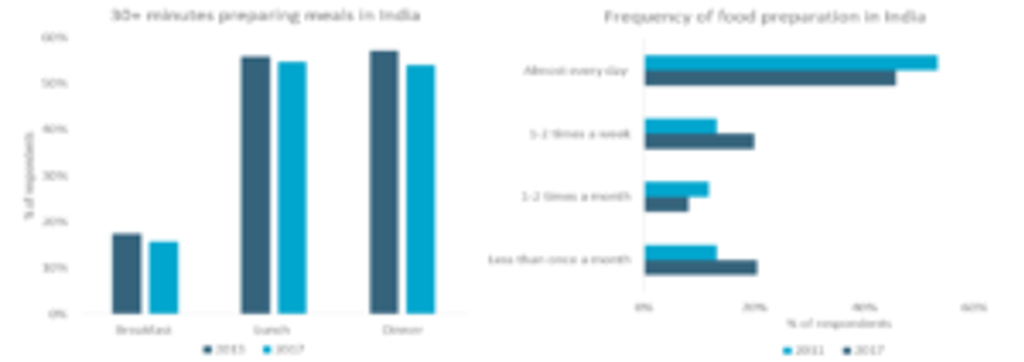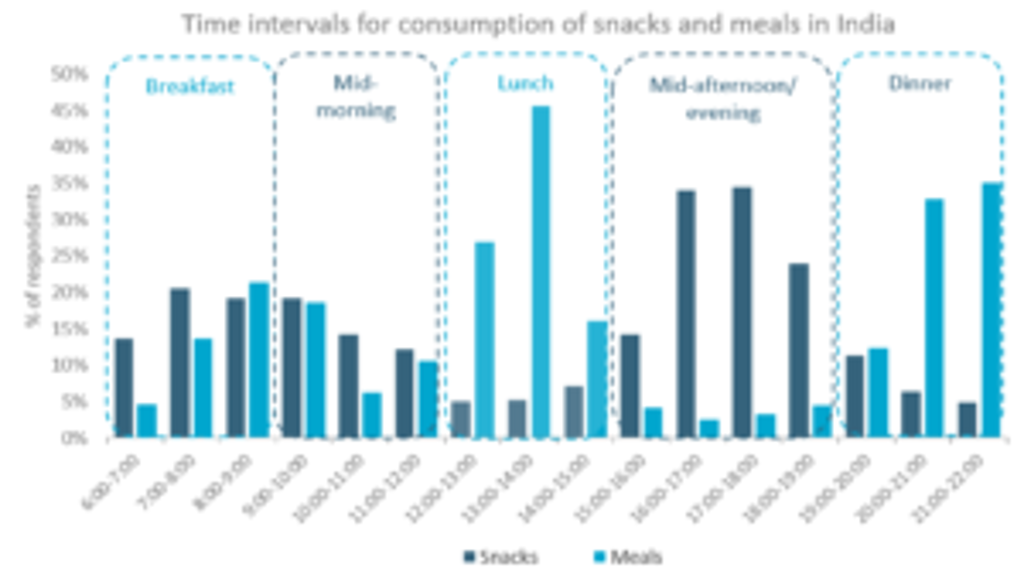Snackification is a trend in which consumers increasingly snack in place of meals and this has altered both the competitive and nutritional landscape of snacks in India. What underlying drivers and factors that have strengthened this trend in recent years?
Time as a form of currency
Consumer lifestyles are evolving in ways that are making time an increasingly scarce resource. Rapid urbanization, growing labour force participation of women are contributing to more time-pressed routines in India. For instance, the actual weekly working hours in the country during 2019 were 46.8 in comparison to the Asia-Pacific and North America average of 43.8 and 33.7 hours respectively. In summary, people in India are increasingly seeking time-saving solutions in all aspects of life as time is becoming a form of currency.
Implications for food: Less preparation, less time spent in the kitchen
As socioeconomic trends create more time-pressed routines for Indian consumers, they are constantly seeking time-saving solutions and higher convenience across various aspects of their life, including their food habits. Due to this, there is a gradual shift towards packaged snacks and pre-prepared food from more time-intensive cooking methods in India such as meal kits and scratch cooking. Euromonitor’s lifestyles survey leaves little question that this move is primarily due to convenience and time savings.

Source: Euromonitor International
With consumer lifestyles in India evolving, the shift toward more convenient food solutions and drive for higher efficiency has resulted in consumers spending less time in the kitchen.

Source: Euromonitor International
Eating habits have become more fluid
The new focus on saving time has also created more fluid eating habits in India. Many consumers are avoiding the traditional “three square” daily meals and instead of eating various on-the-go occasions. Snacking during mid-afternoon and evening was traditionally a common phenomenon in India. In recent years, however, consumers have also indicated a higher preference for snacks over meals during breakfast and mid-morning. A major factor that can be attributed to this trend is the year on year increase in commute time to the office, especially in metro cities such as Mumbai, Hyderabad and Chennai. As a result, consumers are looking for quick, portable and convenient on-the-go solutions for breakfast.

Source: Euromonitor International
The rise of ‘snackification’
The new eating habits have been highly beneficial for growth in packaged snacks and have led to what is termed the “snackification” of food. The allure of convenient, portable and ready-to-eat snacks has led many people in India to consume them in place of a traditional meal. As a result, snacks are increasingly being viewed as substitutes for meals.
Further, consumers snacking in place of a meal are expected to prioritise elements like nutrition and health benefits in the form of high proteins, fiber, vitamins as compared to snacks high in sugar with little nutritional value. As a result, the snackification trend is expected to benefit categories like protein/energy bars, cereal bars, nuts, seeds and trail mixes and yoghurt.
A future of blurred lines for convenient food solutions
As consumers look for more convenient eating occasions, small and single-serve pack sizes have exploded in popularity. The portable nature of snacks allows people to multitask in eating on-the-go. Further, small/single-serve pack sizes are a lucrative way for snack manufacturers to make products available at more affordable price points in rural areas.
Going forward, companies need to adopt a wider view of the competitive landscape for packaged snacks as they increasingly compete for share with freshly prepared snacks or meals. The competition will only increase in the coming years as demand for convenient food intensifies. In this environment, packaged snacks need to leverage their distinct advantages in order to win in convenience-focused occasions.
